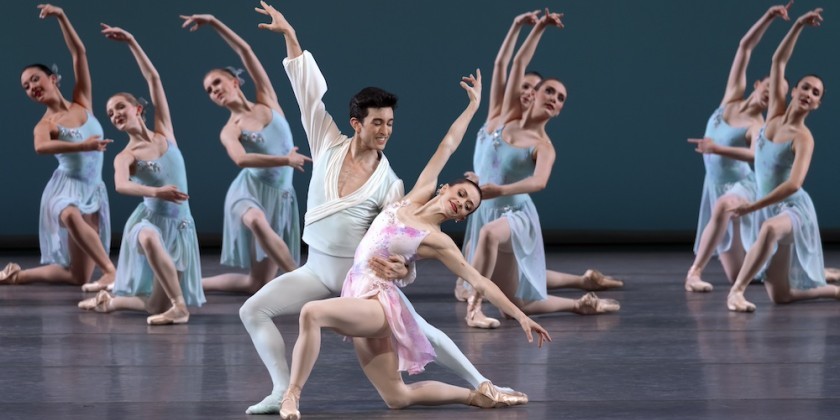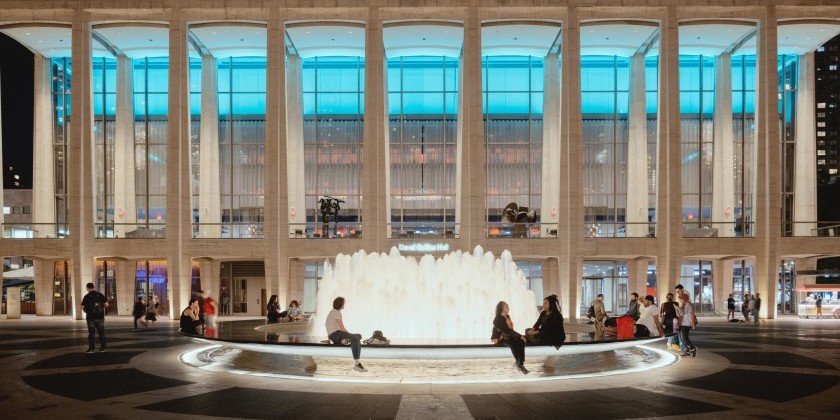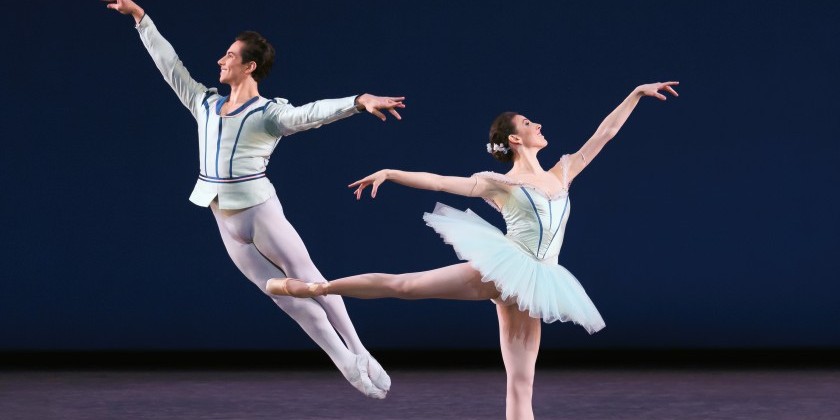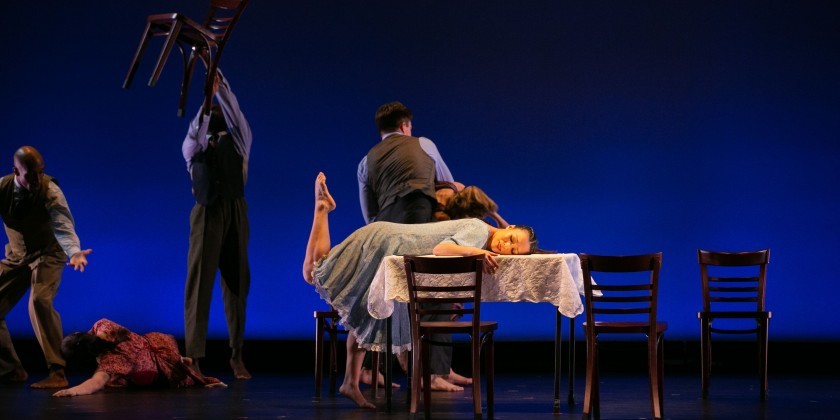IMPRESSIONS: New York City Ballet’s Distinguishing “Classic NYCB” at Lincoln Center

Featuring Superior Performances with Thrilling Dancer Debuts
David H. Koch Theater at Lincoln Center
February 18, 22, and 29, 2024. For tickets, visit the New York City Ballet
Ballo della Regina
Choreography: George Balanchine // Music: Giuseppe Verdi // Costumes: Ben Benson // Original Lighting: Ronald Bates // Lighting: Mark Stanley // Featured Dancers: Megan Fairchild, Anthony Huxley, Ashley Hod, Alston Macgill, Olivia MacKinnon, Emma Von Enck
In a Landscape
Choreography: Albert Evans // Music: John Cage // Costumes: Carole Divet // Lighting: Mark Stanley Dancers: Ava Sautter, Gilbert Bolden III
Hallelujah Junction
Choreography: Peter Martins // Music: John Adams // Costumes: Kirsten Lund Nielsen // Lighting: Mark Stanley // Featured Dancers: Alexa Maxwell, Joseph Gordon, KJ Takahashi
The Concert (or, The Perils of Everybody)
Choreography: Jerome Robbins // Music: Frédéric Chopin // Décor: Saul Steinberg // Costumes: Irene Sharaff // Lighting: Ronald Bates // Featured Dancers: Mira Nadon, Andrew Veyette, Meaghan Dutton-O’Hara
The New York City Ballet launched the third weekend of its winter season this year with a quadruple bill titled, curiously for a company so associated with innovation, “Classic NYCB.” The program comprises co-founder George Balanchine’s showy Ballo della Regina, former principal dancer Albert Evans’s stark In a Landscape, former ballet master in chief Peter Martins’s energetic Hallelujah Junction, and co-founding choreographer Jerome Robbins’s comedic gem, The Concert (or, The Perils of Everybody).
At first, I struggled to understand why these particular pieces were deemed the “classic” works among the troupe’s vast and varied repertoire of 400-plus ballets, made over a span of almost 100 years. But then I realized, it’s not the specific ballets, but rather the combined aesthetics they represent that marks the program as “classic” NYCB. Taken together, the four works evoke the company’s distinctive artistic environment, a world of Balanchinean neoclassicism that pays homage to 19th-century classical ballet, finds fuel in 20th-century modernism, and makes a nurturing home for Robbins’s brilliant theatricality.

Megan Fairchild, Anthony Huxley and the Company in George Balanchine’s Ballo della Regina. Photo: Erin Baiano
Set to majestic ballet music composed for the 1867 Verdi opera Don Carlo, the program’s lively opener, Ballo della Regina, is a delectable speed-fest, with an 18-member cast racing through flashy phrases of petit allegro work and space-gobbling leaps. It reminds us that one of Balanchine’s most thrilling contributions to ballet performance was spurring his dancers to execute technically challenging vocabulary with a never-before-thought-possible rapidity. Costumed by Ben Benson, with lighting by Mark Stanley (after original lighting by Ronald Bates), it’s also a very pretty affair. A female ensemble in wispy mint-green dresses, four soloists in lavender, and the superbly fleet-footed principal Megan Fairchild in pink — all dancing against a cyclorama lit in aquamarine with faint strokes of pale pink — can be seen as subtle references to the original opera-ballet’s story of a fisherman and a pearl. Or, in truer NYCB fashion, the marvelous colors can be experienced solely as formal artistic elements with power to conjure aesthetic responses in and of themselves. After all, it’s this formalistic approach to the art of ballet that is, perhaps, Balanchine’s signature innovation. Nonetheless, after its stirring displays of pure physical virtuosity, Balanchine concludes Ballo della Regina with a slow, regal coda, a nod to classical ballet’s aristocratic roots.
The program’s middle act — the Evans and Martins ballets — blatantly illustrates the modernistic components of Balanchine’s neo-classicism that characterize what many consider the NYCB style. Both are plotless pieces, set to challenging contemporary scores, and danced on a bare stage, in streamlined leotards and tights.

Ava Sautter and Gilbert Bolden III in Albert Evans’ In a Landscape; Photo: Erin Baiano
A duet, exquisitely performed (on February 9) by Ava Sautter and Gilbert Bolden III, both in role debuts, the Evans piece starts intriguingly. Bolden walks slowly across the back of the stage, arm extended. We imagine there is a string tied to his finger as Sautter, lying on her side, slides along behind him as if being dragged by the motion of his arm. He exits and she rises to perform a lonely solo of angular, yet softly impelled motions. He returns, offers her his hand, and richly textured choreography develops. Though of little rhythmic interest, it’s built of startling designs created by the spatial relationships between the two bodies. It abounds in references to familiar Balanchine choreography, yet sadly, bears little relationship to the accompanying John Cage piano and violin score, which feels too spare in comparison. I found myself hearing other music in my head as I watched swirling, expressively executed lifts dwarfing tiny, tinkling piano passages.

Joseph Gordon and Alexa Maxwell in Peter Martins’ Hallelujah Junction. Photo: Erin Baiano
Far less interesting choreographically, Martins’s busy, repetitious work also had me wishing for alternative musical accompaniment. Its relentless John Adams score for two pianos ultimately grows irritating. Yet the dancers saved the day. Also in role debuts, KJ Takahashi whipped off some of the most solidly grounded pirouettes I’ve ever seen, and Joseph Gordon provided impressively reliable support as he partnered Alexa Maxwell through brisk, difficult lifts and complex movement vocabulary. Maxwell, in a New York City role debut, managed to find wonderful moments of expressiveness amid the choreography’s repeated actions and different ways to accent its similarly-constructed phrases.

In yet another of the evening’s role debuts, Mira Nadon gave enchanting interpretation to the lead female character in the program’s laugh-out-loud closer, The Concert. An affectionate, observant parody of the pretentious and annoying behaviors of concert-goers, it remains one of my favorite ballets of all time, mainly because of how easy it is to recognize and identify with its broadly-drawn characters and the sundry and silly scenarios they imagine while listening to Chopin music. Though it was choreographed in 1956, I don’t think I’ve ever seen it so convincingly performed. Bravo to all 21 of its performers, not only for their expert dancing, but for the dramatic clarity of their character renderings, and their riotous execution of the work’s physical comedy bits and balletic slapstick. It was a great demonstration of the timelessness of a classic, and of why I’m going to add “superior performers” to our definition of “classic” NYCB.













